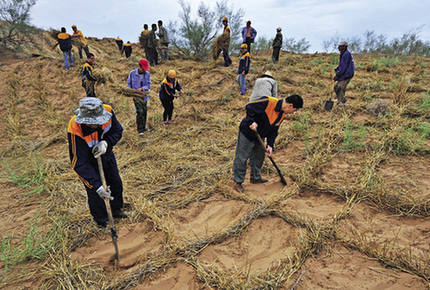Taming Shapotou’s Tengger Desert
By staff reporter ZHOU LIN
Shapotou of Ningxia Hui Autonomous Region, located at the southeastern edge of Tengger Desert, is a district of Zhongwei City; but it was once an expanse of endless sand dunes. The name Tengger, meaning heaven in Mongolian, vividly describes the vast quicksand that stretched as far as the eye could see. Shapotou receives a low amount of precipitation annually, an average of 184.4 mm; however, its annual evapotranspiration rate is up to 3,000 mm and big sandstorms are common.
Tang Ximing of the Forestry and Ecological Construction Bureau of Zhongwei City told us that in recent years, Tengger Desert had retreated by almost 20 kilometers. “In the past, sandstorms were frequent, especially on windy days in the spring. Thanks to a sand control method, they are much less common today.”
|
 |
|
Staff members of the Baotou-Lanzhou Railway use the “grass pane sandfence” to fix shifting sands around the railway line. |
Grass Pane Sandfence
For generations, people in Shapotou have battled with the sand and nurtured a fruitful way of life. “Over the years, our attitude towards avoiding desertification has gradually changed from fear of encroaching sands to taking initiatives to control the dunes, and ultimately, better utilizing the desert to serve us,” Tang Ximing explained.
In the early days of the PRC, the central government resolved to build a railroad from Baotou in Inner Mongolia to Lanzhou of Gansu Province to promote Northwest China’s economic development. However, the Baotou-Lanzhou Railway was designed to intersect the Tengger Desert at six different points on the whole route. A total 55 kilometers of the line was to be constructed in the desert, the section at Shapotou being the most challenging because of immense, shifting sand dunes. A lack of experience in building railways in such harsh natural conditions made preventing the sands from destroying the newly-built railway a burning issue.
Li Minggang, a young scientist at the Chinese Academy of Sciences (CAS), and his colleagues led the Shapotou Desert Research and Experiment Station in the task of fixing the shifting sands. His team systematically conducted experiments on fixing sand around the railway line under poor conditions with no irrigation (groundwater lay 80 meters below the earth’s surface in the construction area). It also innovated a railway protection system for desert areas, the “grass pane sandfence,” that received worldwide commendation.
Today in Shapotou, one-square-meter crisscross grids of straw can be seen everywhere. The thriving district is testament to the method’s great power in preventing sand from devouring people’s cherished land resources.
The squares of straw are in fact the remains of wheat harvests. Dry straw is knocked into the sand and the stems above ground form a natural shelter. Each square-meter grid protects the sand inside from wind and serves as a bed for sand-fixing vegetation to grow. Three to five years later, the decomposed straw will reveal a fine layer of organic matter called a “sand crust.” Formation of the organic layer signifies a successful attempt at ecological protection and sand control.
